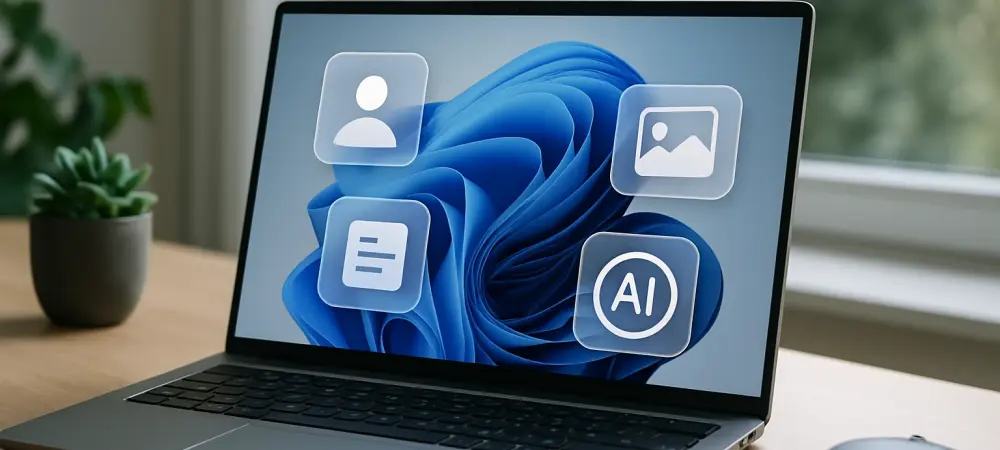Imagine a world where your operating system anticipates your needs, transforms mundane tasks into effortless actions, and prioritizes your privacy with cutting-edge controls. This isn’t a distant dream but a reality unfolding with Microsoft’s latest Windows 11 Insider Preview Build 27938. As AI continues to reshape the technological landscape, Microsoft has taken bold steps to embed intelligent tools into the core of its flagship OS, promising a seamless blend of productivity and innovation. This review dives deep into the AI-driven features of Windows 11, exploring their functionality, impact, and the challenges they face in redefining user experience.
Key AI Innovations in Windows 11 Build 27938
AI Actions in File Explorer
Microsoft has introduced a transformative feature in Build 27938 with AI Actions in File Explorer, designed to streamline image editing directly from the context menu. By right-clicking on supported formats like .jpg and .png, users can access tools such as Bing Visual Search for identifying similar content online, Blur Background for enhancing photo focus, Erase Objects to remove unwanted elements, and Remove Background for quick subject isolation. This integration, dubbed “Click to Do” by Microsoft, eliminates the need to launch separate applications, aiming to boost efficiency for both casual and professional users.
While the functionality is impressive in its simplicity, the scope remains narrow, limited to specific image tasks and file types. This raises questions about how widely applicable these tools are in daily workflows, especially for users dealing with diverse file formats. Nevertheless, this marks a significant first step toward embedding AI into routine file management, hinting at broader possibilities for future updates.
AI Privacy and Security Settings
Addressing growing concerns over data security, Build 27938 introduces detailed privacy controls under Settings > Privacy & Security > Text and Image Generation. Users can now monitor which third-party apps access Windows AI models and adjust permissions accordingly, ensuring greater transparency in how personal data is handled. This move reflects Microsoft’s commitment to balancing innovation with user trust in an era where AI adoption is accelerating.
The significance of these settings cannot be overstated, as they empower individuals to take charge of their digital footprint. For those wary of potential misuse of AI capabilities, this feature offers a layer of reassurance, though its effectiveness will depend on consistent updates and user education. It’s a proactive approach that aligns with industry demands for accountability in technology.
Broader Updates in Build 27938
Beyond AI, Microsoft has responded to longstanding user feedback by enhancing the clock display in the Notification Center. Accessible via Settings > Time & Language > Date & Time, the updated clock now shows seconds alongside date and calendar details, a small but meaningful nod to requests dating back several years. This tweak highlights a dedication to refining user experience with practical adjustments.
Such updates, while seemingly minor, demonstrate a willingness to address community input, blending nostalgia with modern design. It’s a reminder that not all advancements need to be groundbreaking; sometimes, fulfilling basic expectations can significantly enhance satisfaction. This balance of innovation and familiarity is a key strength of the build.
Practical Impact on Users
The AI Actions in File Explorer hold particular promise for creative professionals and casual users alike, simplifying tasks like photo editing without requiring specialized software. Imagine a graphic designer quickly isolating a subject for a project or a student enhancing a presentation image—all directly from the desktop. These tools reduce friction in workflows, potentially saving valuable time.
On the privacy front, the new controls cater to a wide audience concerned about data exposure in an AI-driven world. For everyday users sharing images or using third-party apps, the ability to restrict access to AI models offers peace of mind. This dual focus on utility and security shapes a more thoughtful interaction with technology, though adoption may vary based on individual comfort levels with AI.
Hurdles in AI Implementation
Despite the potential, the AI features in Build 27938 face limitations that could temper enthusiasm. The restriction of AI Actions to specific image formats and tasks means many users might not find immediate value in them, especially those working with diverse content. Expanding this functionality will be crucial for broader relevance, a challenge Microsoft must tackle in future iterations.
Additionally, there’s the risk of user skepticism regarding the necessity of AI in such contexts. Some might view these tools as intrusive or redundant, preferring traditional methods over automated solutions. Overcoming this perception, alongside ensuring robust technical performance across devices, remains a hurdle for widespread acceptance.
Looking Ahead for Windows AI
The trajectory of AI in Windows 11 appears poised for expansion, with potential to include more file types and complex tasks beyond image editing. Envision a future where AI Actions assist with document analysis or automated file organization, further embedding intelligence into the OS. Microsoft’s vision seems geared toward a holistic integration of AI, positioning Windows as a leader in smart computing.
However, this ambition must navigate ongoing debates around privacy and the competitive tech landscape. Striking a balance between powerful features and user autonomy will define the success of these advancements. As development progresses from this year to the next, the evolution of these tools could reshape expectations for operating systems globally.
Final Thoughts
Reflecting on the journey through Windows 11 Insider Preview Build 27938, the strides made in AI integration stand out as both promising and cautiously implemented. The AI Actions in File Explorer offer a glimpse of streamlined productivity, while privacy controls address critical user concerns. Yet, the limited scope and potential skepticism highlight areas needing refinement. Moving forward, Microsoft should prioritize expanding the versatility of AI features to encompass a wider range of tasks and file types, ensuring relevance for diverse users. Simultaneously, reinforcing privacy measures through clear communication and updates will be essential to maintain trust. As these elements evolve, stakeholders and users alike should actively engage in testing and feedback, shaping a future where Windows not only innovates but also resonates deeply with its community.

